Spring is always big decision making time at weedom, and the number of required, executive functions fairly clogs the brain. Some nominally cultivated areas had been allowed to overgrow, which provided about half of the weed pictures featured so far in the newsletter. Now is time to reorganize them just a bit.
Surrounding the house is a formerly ordered landscape area which has, in more recent years, accepted medicinal weeds, and become “naturalized”. That is the word and the excuse employed for the disorder of weedom :-D
Each spring there are endless decisions of which weeds to keep, which to pull, and where to cultivate some that we use for medicine and food. Normal people can go into the landscape, nuke the weeds completely, put in some perennials and annuals, and add mulch. But at weedom, the removal of weeds is a both a manual and mournful task. Each newly appearing species has to be checked out for edibility and medicinal qualities, as well as whether it will play well with the other weeds and the few, previously planned species that remain. Mulching is also a wrenching decision since it covers up and might inhibit the germination of some really cool weeds that have not yet appeared. What is normally landscape surrounding usual dwellings is a wholly a different thing here.
You knew there had to be a weirdo writing this SubStack 🙃
It’s time to give an example of what happens when a “new” weed is found. This featured weed might have gotten pulled as a mere shoot, in the past, but was never seen or smelled in its mature form in the landscape before. Yesterday our new weed, at its full 18 inch height, demanded attention, and objected to eradication.
That means it now has a spot in the landscape. And it’s physical identity has been elucidated. Geum urbanum has invaded the farm, and has permanently claimed territory.
Since yesterday, we found that this little Eurasian weed has considerable reputation in the Old World, and numerous names. St. Benedict’s root, wood avens, colewort, and clove root are some of the common monikers. Yanking a couple of plants in the stone walkway revealed that the clove root name is apt and truthful. The famous eugenol anaesthetic and flavorful compound, found in cloves, is definitely detectable in the roots by smell and taste, and this apparently is responsible for a good part of the plant’s traditional utility and cultivation. The other feature is that the leaves can be eaten, though the flavor is not a standout, and they are just a bit hairy. Still they’re at least palatable raw, and are improved with cooking in the manner of spinach, adding a bit of bacon grease which reliably alleviates most issues that people might have with the wild greens.
Though newly acquainted with this weed, it’s still possible to accord it a brief weedom introduction, though most of what we personally do with it still has to be worked out as we give it some space.
Geum urbanum, of the family Rosaceae, but entirely lacking thorns, is hardy to USDA zones 4-9. This perennial plant prefers partial shade and does better with sufficient precipitation, which explains why it popped up this Spring rather than during our dry years. Among its relatives is Geum rivale (chocolate root or water avens) a larger wetland plant with later blooming time, and more bitter flavored roots reminiscent of unflavored chocolate. Another relative, tolerating more northerly regions, is Geum macrophyllum, a.k.a. large leafed avens. In the eastern U.S. are Geum virginianum with its cream colored flowers, and the white petaled Geum canadense to the north east, both of which have been said to hybridize with our weeds to form vigorous but less fertile offspring. Our readers in the UK are most likely to have extensive familiarity with plants from this genus.
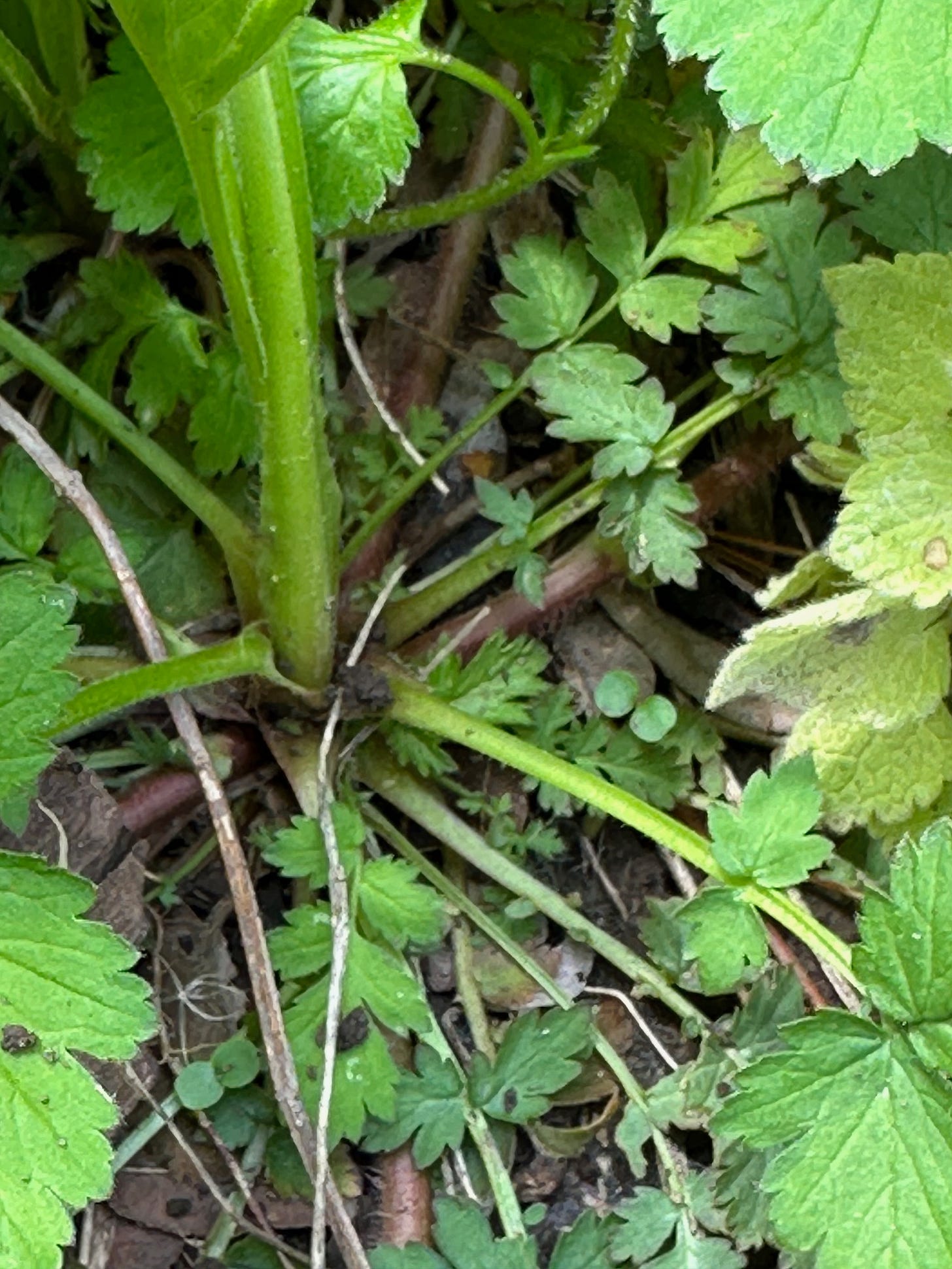
Leaves of our cloveroot are all sorts of shapes, with the basal leaves being pinnate, the most distal leaflet being triply lobed, and the proximal leaflets being smaller and more oval. The next set of leaves above the basal rosette are triply lobed, and the smallest upper leaves of flowering stems are more often divided into three oval leaflets. Others find that this plant, when younger, reminds them of wild strawberries, although leaves of the latter have more regularly toothed margins. The chance of mistaking this plant for a toxic weed seem to be rather low.

Flowering at weedom, in USDA zone 6, cloveroot sports 5 bright yellow petals and 5 green sepals on its tiny blooms. The flowers are hermaphroditic, with a ring of anthers surrounding the central female structures. The fruiting head of Geum urbanum produces numerous achenes, which are single seeded fruits that do not open to release the seed. These clingy things easily travel with any passers by to spread the the seeds, and therefore propagate the weeds far and wide.
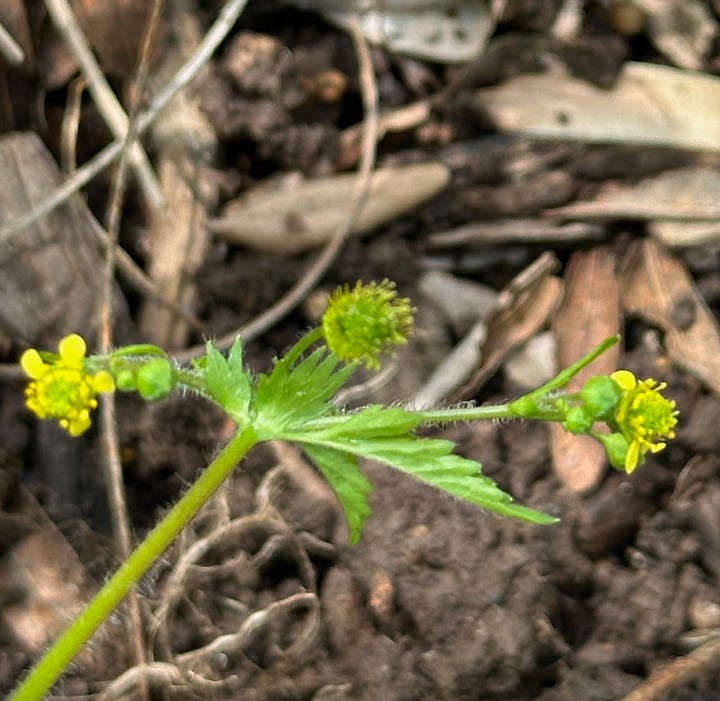
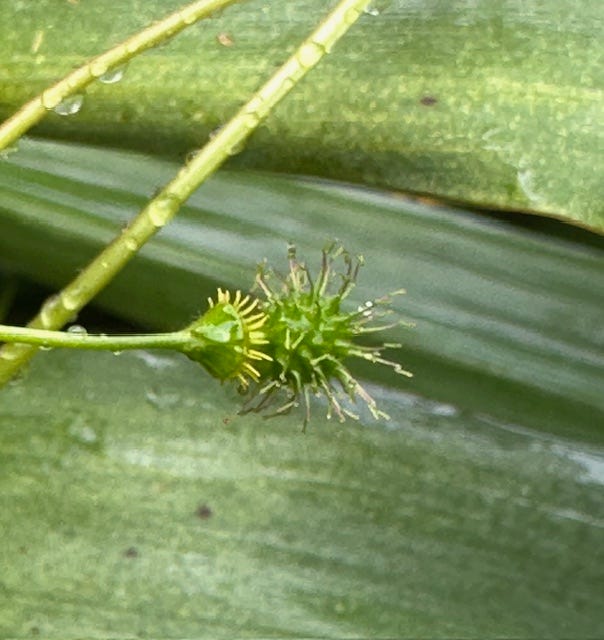
Fortunately the roots are clove scented whenever you pick them, which will help you to know you have the right plant. You might have to clean or bruise the roots to pick up the scent at first. Ours had a noticable smell when broken. Those who want more roots for less work will harvest them during the winter or early spring. This perennial is hardy up through zone 6, so look for the rosettes where you see the full grown ones this year, and grab those in order to obtain larger root clusters. By the time the plants are full grown, the roots are quite diminished in size, though still flavorful. Others in our zone 6 have reported getting optimal harvest in February, early March. Likewise the leaves harvested in late winter to early spring are a bit better in texture for eating.
Hydrodistillation of the root will produce about 0.5% percent of essential oil, which yields close to 70% of eugenol, the characteristic monoterpenoid anaesthetic oil present in cloves. A prominent minor component is another monoterpene, myrtenal, which imparts a woody cinnamon fragrance and some anticholinergic activity that might, along with the prominent tannins present in the root, justify the traditional use as an anti-diarrheal.
To take best culinary advantage of the gifts of this weed, using the fresh roots will yield the best flavor in syrups or in liqueurs. Making syrup of at least 2 parts sugar to 1 part water, and gently simmering the fresh roots to extract the flavor is one way to preserve the goodness. The syrup could have numerous applications as toppings or in cooking and to spice up certain fruits and baked goods. Extracting the fresh roots into 40 percent hydroethanolic solution is another way to preserve the clove and cinnamon spicy flavor. The roots are best be dried at room temperature in the dark, rather than using a dehydrator. High heat tends to dissipate small aromatic molecules that contribute to the flavor. Mark at Galloway Wild Foods goes as far as to dry and powder his roots after extracting them into syrup, and to use the powder as a sweet flavoring. He doesn’t waste a bit. Follow that link above for some more culinary ideas for utilizing the roots of our weed.
This December will be the time at weedom to check for enough usable roots to experiment with some syrup making. From that time through the winter is the easiest root gathering season, mainly for bulk. Readers who have experienced the fullness of Geum urbanum are especially invited to weigh in.
Lastly, this root at medicinal doses, which we have not truly addressed, is not for the pregnant.
Have you experienced the angst and executive overload of deciding which weeds to spare, and which to yank when organizing your landscape or gardens? Which weeds took you to the wild side? Have you given up some territory completely? Feel free to post in the comments. We won’t judge. :-D
Where We Dig
1. Wood avens (Geum urbanum) identification. Accessed May 1, 2025. https://www.foragingcoursecompany.co.uk/post/foraging-guide-wood-avens
2. Wood Avens – Edibility, Identification, Distribution, Ecology, Recipes – Galloway Wild Foods. Accessed May 1, 2025. https://gallowaywildfoods.com/wood-avens-edibility-identification-distribution/
3. Thayer S. Sam Thayer’s Field Guide to Edible Wild Plants of Eastern & Central North America. Forager’s Harvest; 2023.
4. Grieve M. Modern Herbal. Echo Point Books & Media, LLC.; 2015. https://openlibrary.org/books/OL36722889M/Modern_Herbal
5. Geum urbanum Wood Avens, Bennet’s Root - Old man’s whiskers, Herb bennet PFAF Plant Database. Accessed May 1, 2025. https://pfaf.org/user/Plant.aspx?LatinName=Geum+urbanum
6. Geum urbanum (Wood Avens) - Practical Plants. Accessed May 1, 2025. https://practicalplants.org/wiki/geum_urbanum/
7. Geum urbanum - FNA. Accessed May 1, 2025. http://floranorthamerica.org/Geum_urbanum
8. Owczarek A, Gudej J, Kicel A. Composition of essential oil from aerial and underground parts of Geum rivale and G. urbanum growing in Poland. Nat Prod Commun. 2013;8(4):505-508.
9. Ton That Q, Nguyen Thien TV, Dang HP, et al. Chemical constituents of Geum urbanum L. roots. Nat Prod Res. 2018;32(21):2529-2534. doi:10.1080/14786419.2018.1425844
10. Dimitrova L, Zaharieva MM, Popova M, et al. Antimicrobial and antioxidant potential of different solvent extracts of the medicinal plant Geum urbanum L. Chem Cent J. 2017;11(1):113. doi:10.1186/s13065-017-0343-8


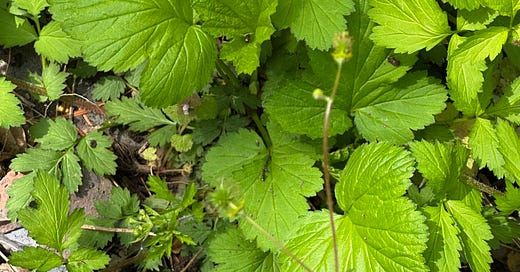



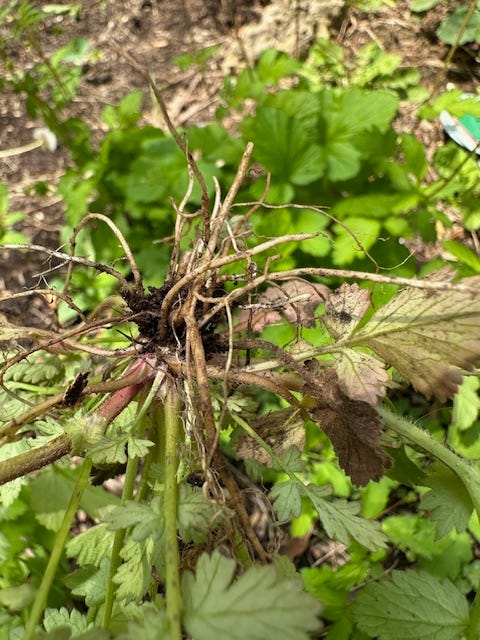

You probably already use this site, but if not its really useful and one of our favourites! https://pfaf.org/user/Default.aspx
fascinating. thank you. always wondered what that was and why it had a wonderful smell when I whacked it from our vegetable garden. (sorry)